Art and Nature Parks: On Common Ground
July 9, 2020 / 0 Comments
Walking in the Eastern Woodlands of the Laumeier Sculpture Park in St. Louis, one discovers an open clearing in which lies a large concrete basin surrounded by a skeletal wooden structure all weathered by the forces of nature and time. The central pond-shaped form, cracked and empty save for a few fallen leaves, was once a swimming pool on a 20-acre estate uncovered by Laumeier staff when it acquired the land in the early 1980s. The trellised structure, a labyrinth of elevated walkways and gazebos, is an installation by artist Mary Miss who constructed the work in 1982-85 upon the remnants of the estate’s original architecture. Entitled Pool Complex: Orchard Valley, the one-acre, site-specific intervention performs an archeology of the land’s previous use and history, while configuring a spatial environment that enables visitors to observe and encounter the forested landscape. Through its own natural entropy, the work has become itself a kind of ruin – at once worn, serene, and ghostly – suspended between past and present and the story of its future being. As such, Pool Complex is a memory site, layered with histories and encounters both private and public; it is also an example of how art can collaborate with the natural world to create deep connections to place.
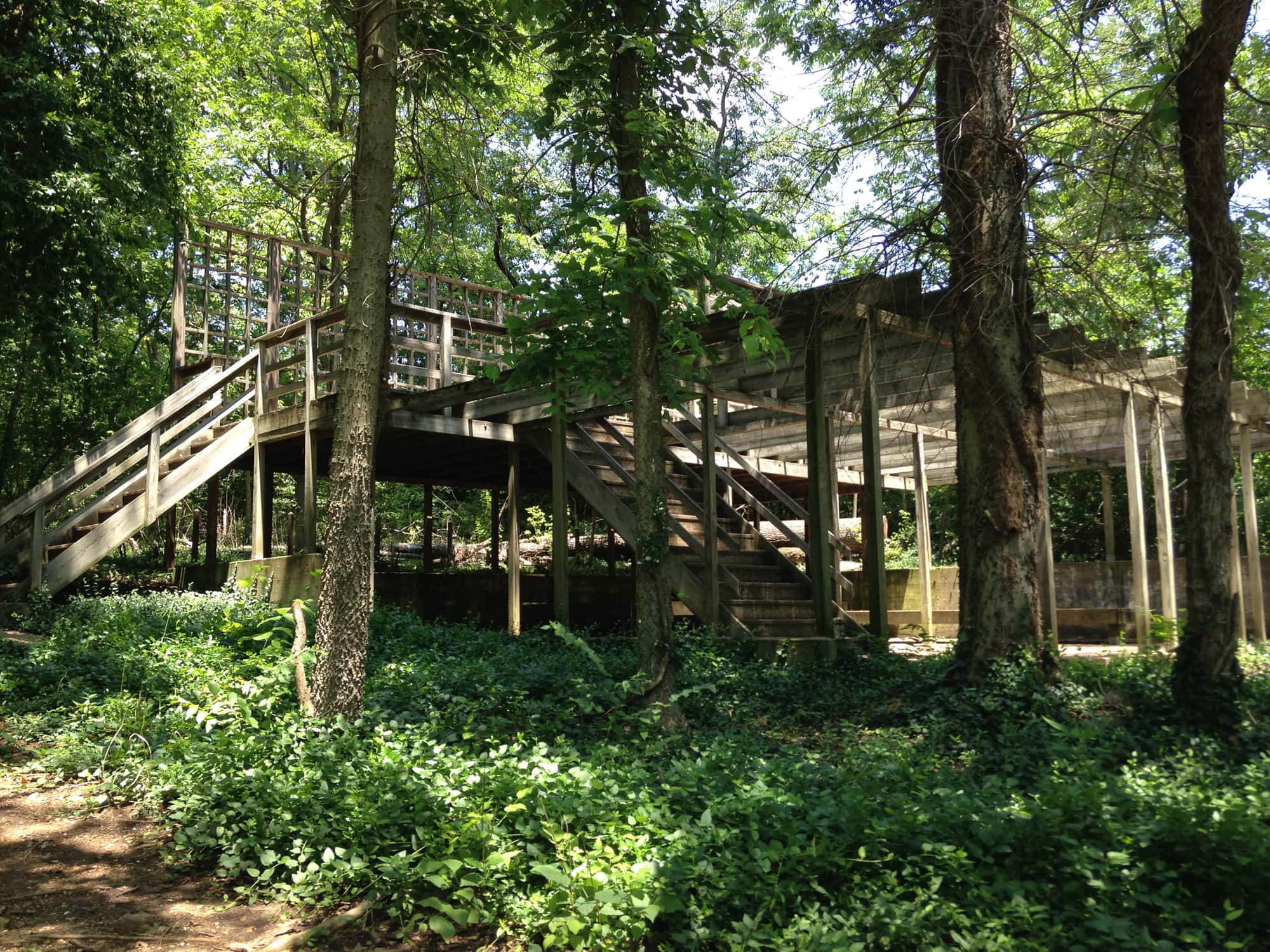
The above work merges aesthetic experience, the pleasure of walking, and immersion in nature, a trio of interactions between the mind, the body, and the senses that are the hallmark of Miss’s practice and the parallel mission of outdoor sculpture parks. It also belongs to a series of artistic encounters that have fueled my larger inquiry into what role art and nature parks might play in environmental stewardship, particularly within urban spaces. How can these hybrid environments raise awareness and educate diverse publics about climate change? How do they nurture new environmental art forms while animating the often-static nature of outdoor public works towards more ecological ends? How do these green cultural spaces maintain and protect the ecosystems they inhabit?
These questions have guided my travels to various art and nature parks over the course of the last year or so, including Storm King Art Center in Cornwall, New York, and Newfields in Indianapolis, in addition to Laumeier. While united in their goal to create public encounters with contemporary art in immersive outdoor environments, they offer experiences as diverse as the artworks they collect or commission and the native ecologies that fall under their care. What follows is based on these experiences, part of a continued search for environmental art practices that advocate for planetary care. Writing while still sheltering in place from my apartment in downtown Chicago, this essay is also a lament for the art and nature that now feels so remote.
Laumeier Sculpture Park
I have experienced Miss’s Pool Complex on various occasions – my memories imprinted with its quietude and scale – and visit Laumeier often, including in May 2019, the day after St. Louis suffered several damaging storms that left the park grounds sodden and portions of its collection closed to public view. My last visit was in early March of this year, shortly before the world was shuttered by the coronavirus. On view was “Mark Dion: Follies,” a survey of the artist’s architectural installations that spin on the historical folly, a form of decorative architecture created for the aristocratic gardens of eighteenth- and nineteenth-century Europe to provide excursionists with a sense of wonder. (Note 1) Dion’s follies, exhibited in Laumeier’s spacious indoor gallery as well as its outdoor campus, are cottagelike curio cabinets filled with found objects and intimate, themed tableaux. Emulating storage huts, grottos, field stations, and hunting blinds, these small dwellings continue the artist’s ongoing interests in ecology, climate breakdown, and natural history display – their ironical forms and urgent subjects taking on heightened, new meaning during our current shelter in place.
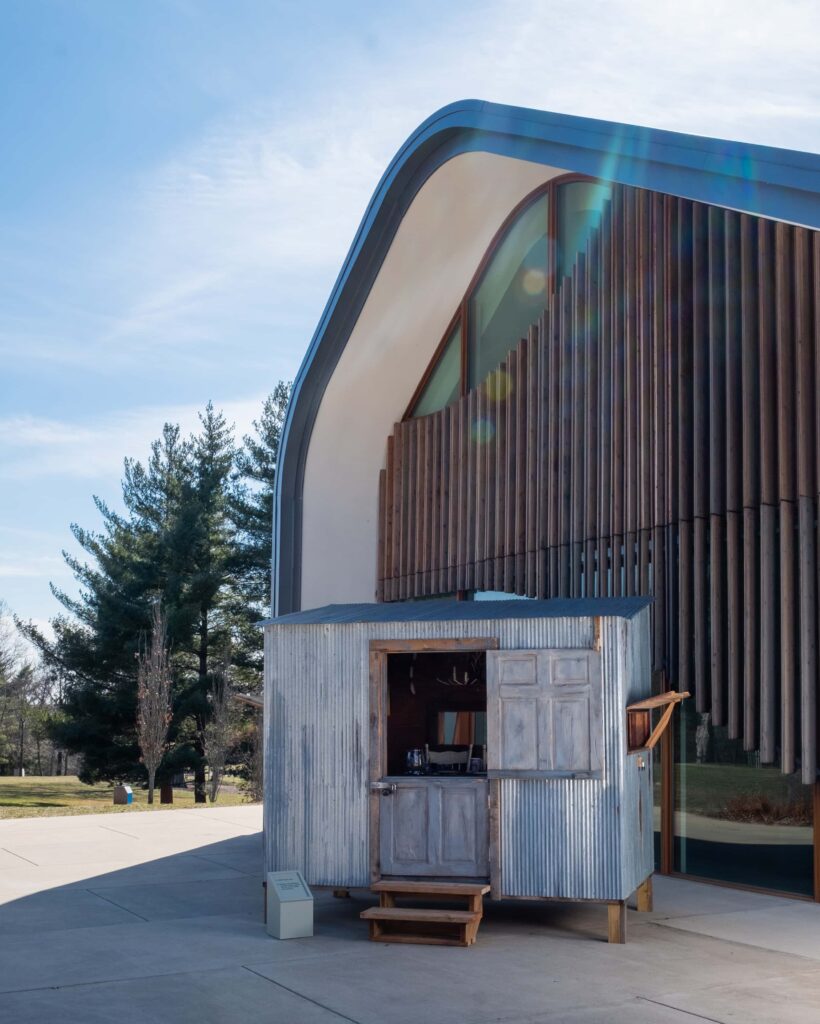
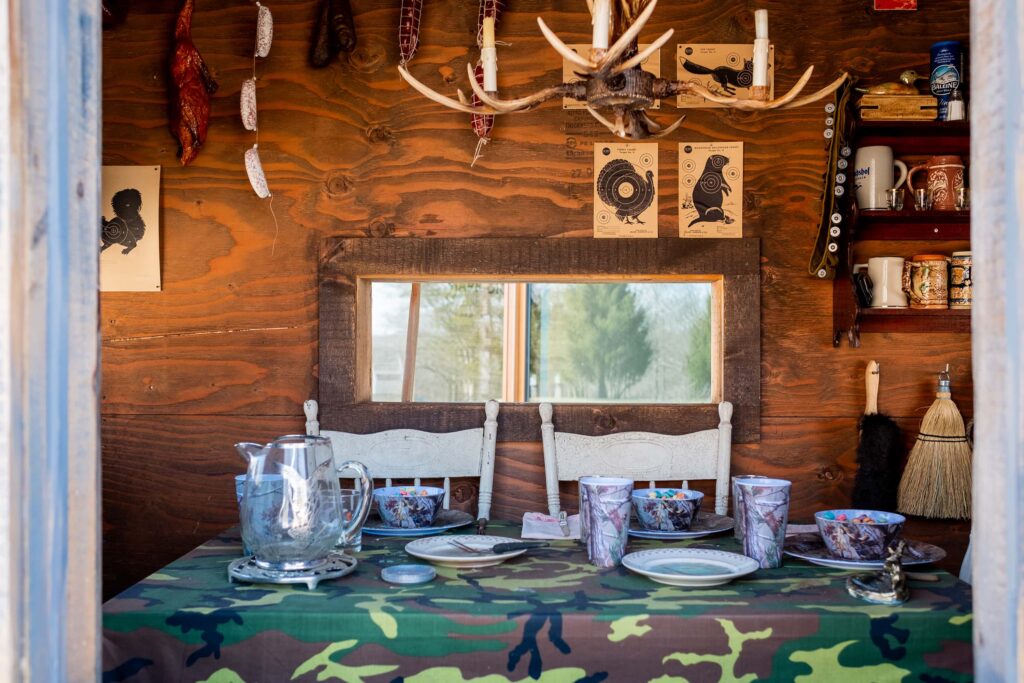

Also on view was Dion’s Memento Mori (My Glass is Run) (2004), a faux graveyard honoring American naturalists of the eighteenth and nineteenth centuries, among them painter Charles Wilson Peale, poet and ornithologist Alexander Wilson, and Jane Colden, considered the first American woman botanist. Installed in a grassy knoll at the foot of Laumeier’s Museum Lawn, the tombtones, marked with poetic and sometimes humorous epitaphs, pay tribute to the early biological studies of those whose names they bear, at the same time asking viewers to consider the landscape where these figures are symbolically laid to rest. Like the artist’s follies, Dion’s monuments position their vernacular forms within the broader context of environmentalism and public art, seeing cemeteries as “open parklands, and therefore, a reservoir of wildlife,” notes Dion, as well as “the greatest sites of public sculpture.” (Note 2) Moreover, Memento Mori reminds us of our existence as biological beings and the transient nature of human life – the work’s themes of loss and death an unintended memorial to the victims of our current pandemic.
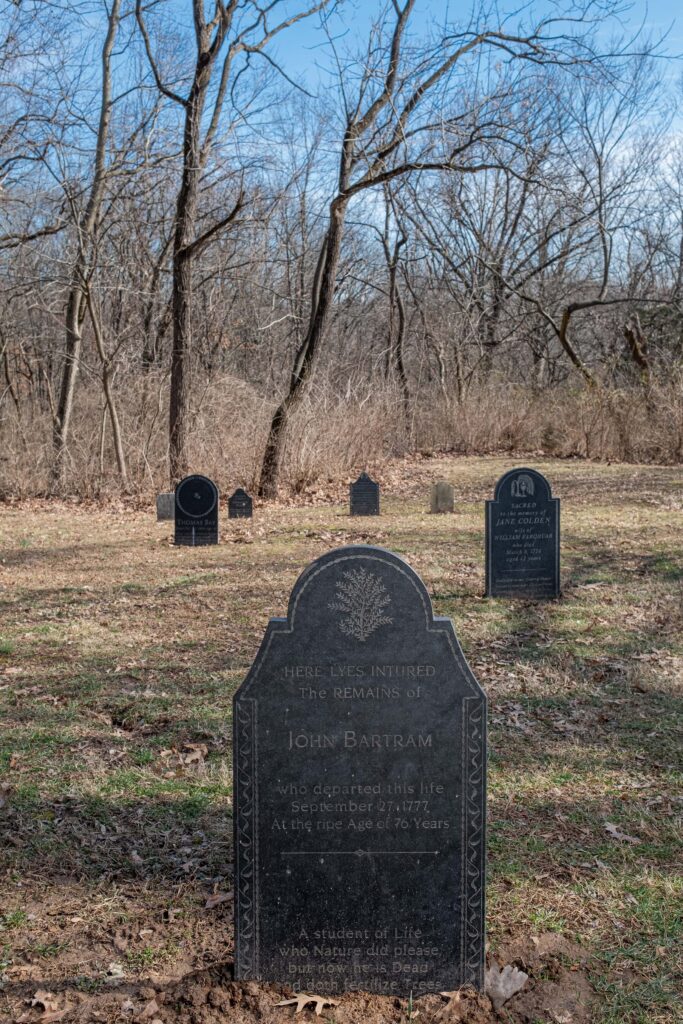
“Follies” was the latest exhibition in Laumeier’s ongoing series of temporary projects dedicated to contemporary sculptural practices that expand the content and forms of public art. Dion’s architectural installations (first on view at Storm King Art Center in 2019), balance humankind’s need for organizing nature and moments of discovery, not unlike Laumeier’s own verdant environment, a 105-acre sculpture park founded in 1976 in the midst of a large urban center that sits on the western bank of the Mississippi River. “Laumeier is both a park and a museum,” Director Lauren Ross told me, “a hybrid space where art and nature are presented in a fertile overlap,” at the intersection of “wellness and urban design.” Its permanent collection of 60 works reflects the historical arc of public art, from classic, large-scale sculptures of the modernist mold to some of the best examples of Land Art to more recently commissioned works by local and regional artists that speak to the city’s history and diverse demographics.
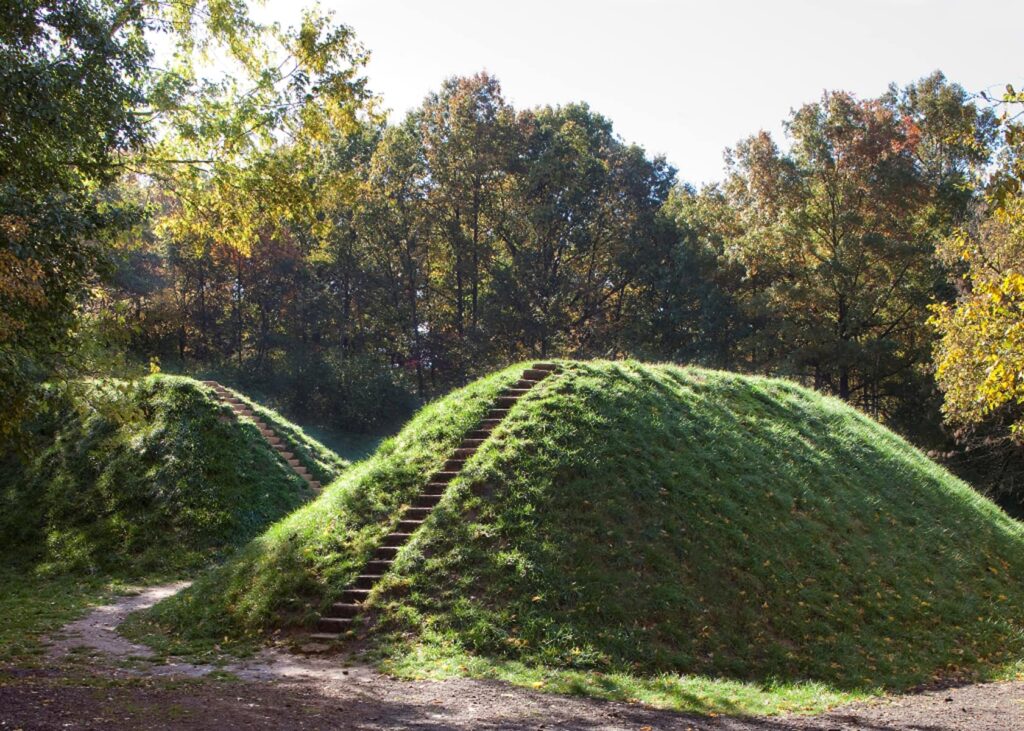
For me, the many works that join Miss’s Pool Complex in the Eastern Woodland area endure as Laumeier’s most impressive: Dan Graham’s mirrored triangular bridge that spans a small creek; Beverly Pepper’s earthen amphitheater of pyramidal forms that recall the area’s Native American mounds; Jackie Ferrara’s slotted wooden ziggurat at the head of the Nature Trail that serves as a space “to rest and observe the beams of sunlight peeking through [its] cedar walls.” (Note 3) Commissioned under the auspices of Laumeier’s Ten Sites program (1981-1991), these land-based works converse with their respective environments, affording viewers shifting perspectives on the park-museum’s landscape as it transforms with the seasons and across time.
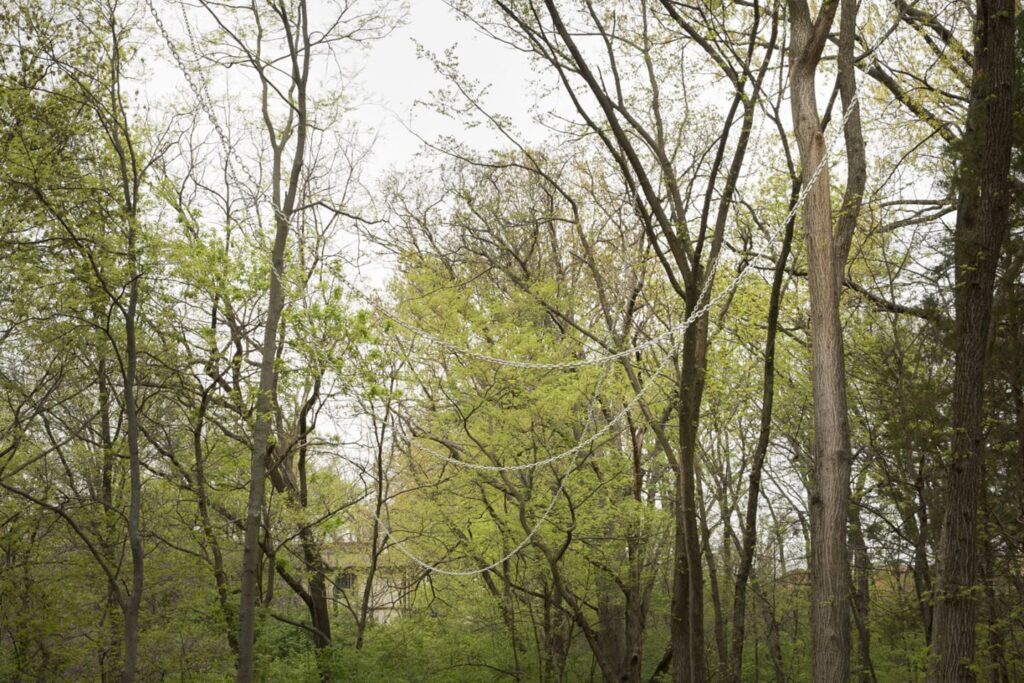
The site-specific nature of these works also makes them vulnerable to the environmental elements with which they collaborate, including weather, animals, and invasive species, as well as human interaction, pollution, and climate change. For example, the mounds of Pepper’s Cromlech Glenn (1985-90) have been reinforced with netting to thwart erosion from rain, while Miss’s Pool Complex has been left – at the artist’s request – to naturally degenerate. More recently, Sam Durant’s Free Hanging Chain (2014), five catenary metal chains suspended in a wooded area at the edge of the sculpture park’s Way Field, was taken off view when the supporting trees were infected with Dutch Elm disease. Durant’s work speaks to histories of slavery and was commissioned in 2014 for the group exhibition “Mound City,’ which explored the political and cultural legacies of the native-mound cultures that once occupied the St. Louis region.
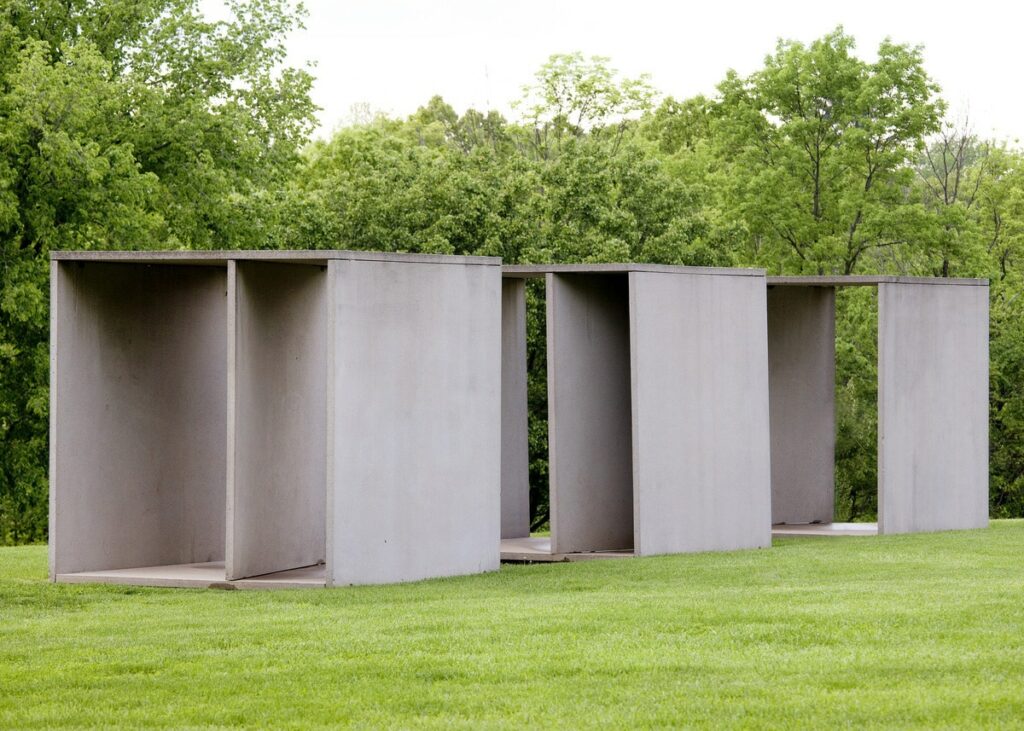
According to Ross, conservation is fundamental to Laumeier’s mission. In addition to ongoing care and maintenance of its grounds and collection, this includes major renovations to key works, such as Alexander Liberman’s The Way (1972-80), a monumental sculpture composed of 18 salvaged steel oil drums painted red, for which Laumeier recently received a conservation grant from the National Endowment for the Arts. Conservation of Donald Judd’s Untitled (1984), a succession of three open-ended concrete cubes that commands the campus’s South Lawn, was completed in 2014. With preservation of existing works currently taking precedence over new acquisitions, the curatorial focus has been on temporary projects devoted to contemporary practices and critical issues, and on education. For example, “Art and Global Change,” a year-long examination of environmental practices and climate change, scheduled to unfold in late August 2020 , extending Laumeier’s fundamental commitment to art and nature through public programs and an exhibition. Teen and family workshops will engage broad publics in science-centered research and discovery of local bird species, while Laumeier’s Cultural Thinker in Residence program (instituted in 2012) invites local biologists to lead public discussions about the impact of climate change on bees and insects. The group show The Future is Present: Art and Global Change will feature works by Daniel Canogar, Hannah Chalew, Pete Froslie, Jenny Kendler, Van McElwee, Elias Sime, Calum Stirling, and Marina Zurkow. This impressive mix of regional, national, and international artists employ sound, video, and virtual reality to address such issues as deforestation, changing weather patterns, technological waste, and the earth’s melting ice caps, alongside artworks that will map and document Laumeier’s native trees and fauna.
Storm King Art Center
Raising public awareness about environmental issues through art and ecological practices was also the curatorial aim of the exhibition “Indicators: Artists on Climate Change” (2018), on view during my visit at Storm King Art Center, just 50 miles north of Manhattan in Upstate New York. (Note 4) I was met that sun-filled day in early November 2018 by unexpected, bitter-cold winds that swept across Storm King’s 500-acre site, a diverse landscape of grassy meadows, woodlands, reclaimed farmlands, and expansive green fields, each displaying their brilliant fall hues.
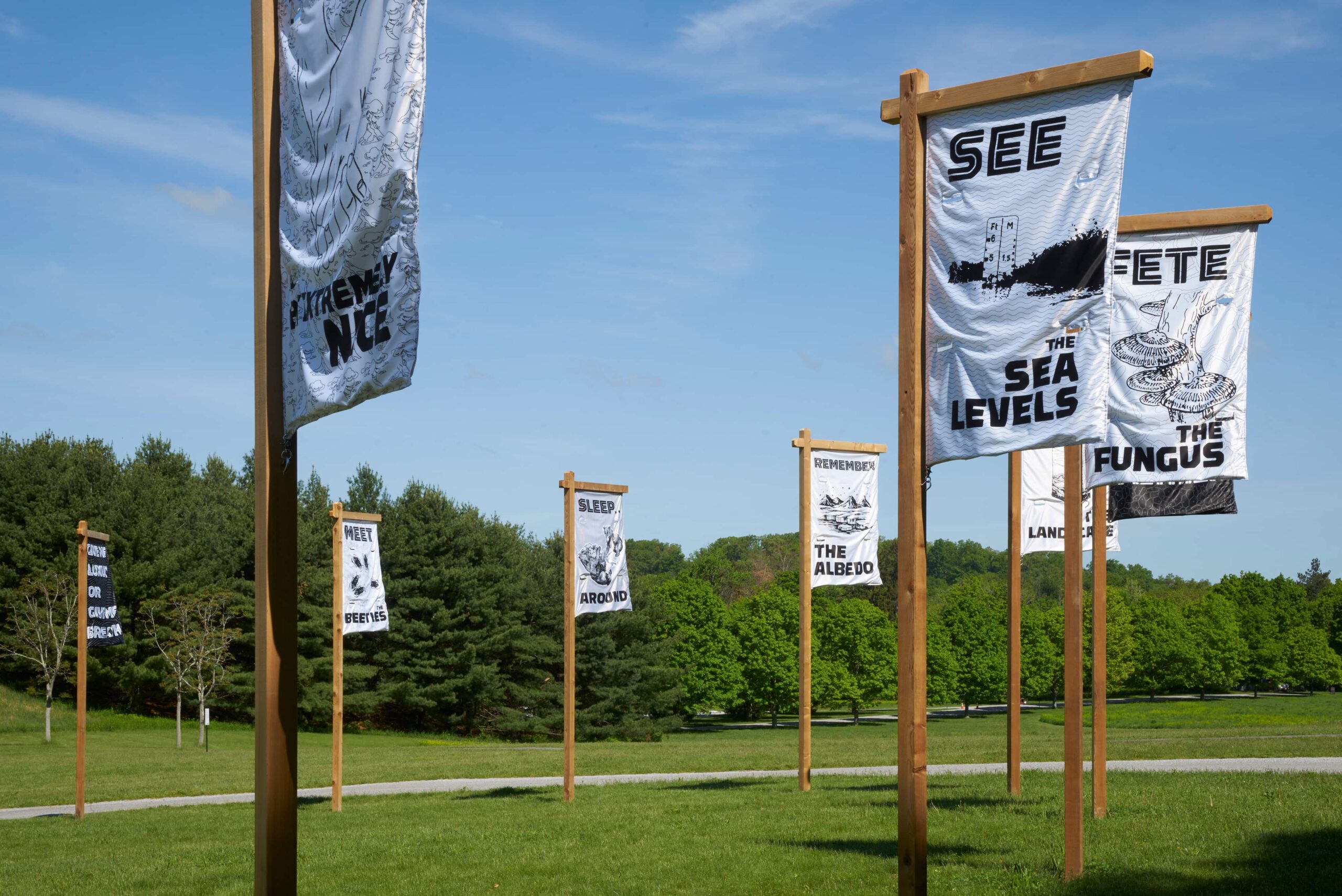
“Indicators” featured the work of 17 artists, who through a broad range of media and conceptual practices made visible the multiple, varied impact of climate change on Earth’s geology and biological systems. Works exhibited in the center’s intimate indoor galleries are less tangible to me now – perhaps because their presentation followed more traditional forms of museum display – and thus those projects sited outdoors, mainly along the perimeter of the park’s South Fields, remain in my memory. These include several large-scale installations that appropriated public signage as a form of urgent address, such as Justin Brice Guariglia’s solar-powered LED highway signs, whose flashing texts –“We Are the Asteroid,” “Danger: Anthropocentricism,” “Neanderthals R Us” – warned of the devasting effects of human activity upon the environment. The collective Dear Climate parodied activist slogans in their work General Assembly (2018), a circular procession of 20 black-and-white banners that, as its title and ceremonial form suggest, evoked a United Nations assembly. Juxtaposing simple graphics and text, for example the words “Fete the Fungus” with an image of a tree trunk sprouting mushrooms or “Meet the Beetles” with a swarm of black beetles, the piece offered a humorous yet declarative reminder that Earth is shared by human and nonhuman inhabitants alike.
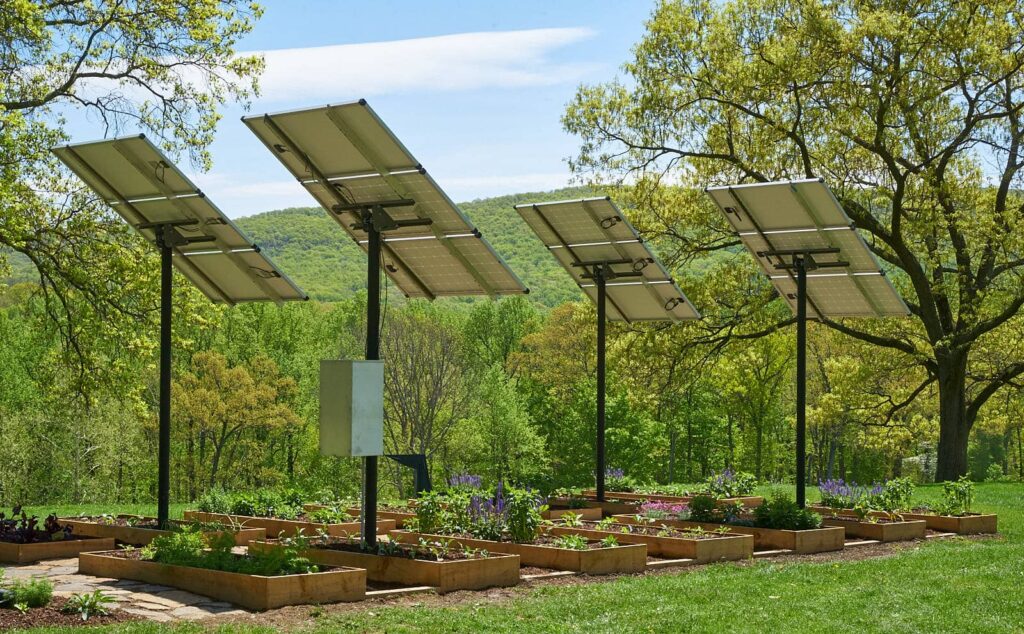
Other outdoor projects presented creative models for regenerating local plant life and nurturing biodiversity, including Meg Webster’s solar-powered garden, Mary Mattingly’s transplanted tropical fruit trees, and Maya Lin’s tubular structures that revealed the root systems of native prairie grasses. Conceived as living sculptures, these more situated works directly engaged Storm King’s local landscape and native ecologies, providing long-term solutions for environmental restoration and preservation.
“Indicators” expanded the view of artistic responses to climate change in a grand natural setting that hosts approximately 200,000 visitors annually. It also reinforced the core mission of Storm King, which was conceived as an “environmental project” from its inception in 1960. According to its website, the founders of Storm King acquired 200-acres of land decimated by the construction of the New York State Thruway in the 1950s, which left the former farmland a massive gravel pit depleted of topsoil. Through extensive and continuous reclamation efforts, the compromised land was converted into a landscape for sculpture in 1967 with the acquisition of thirteen works from the estate of David Smith. While at once an outdoor museum for large-scale public art (with a collection of some 100 works), Storm King has also been instrumental in the environmental stewardship of both its own site and the surrounding landscape. Central to this work has been the restoration of its many natural habitats, including the original farmland and adjacent fields through its Art Farming program that since its inception in 1997 has reintroduced native grasses and wildflowers to what is now the campus’s South Fields.
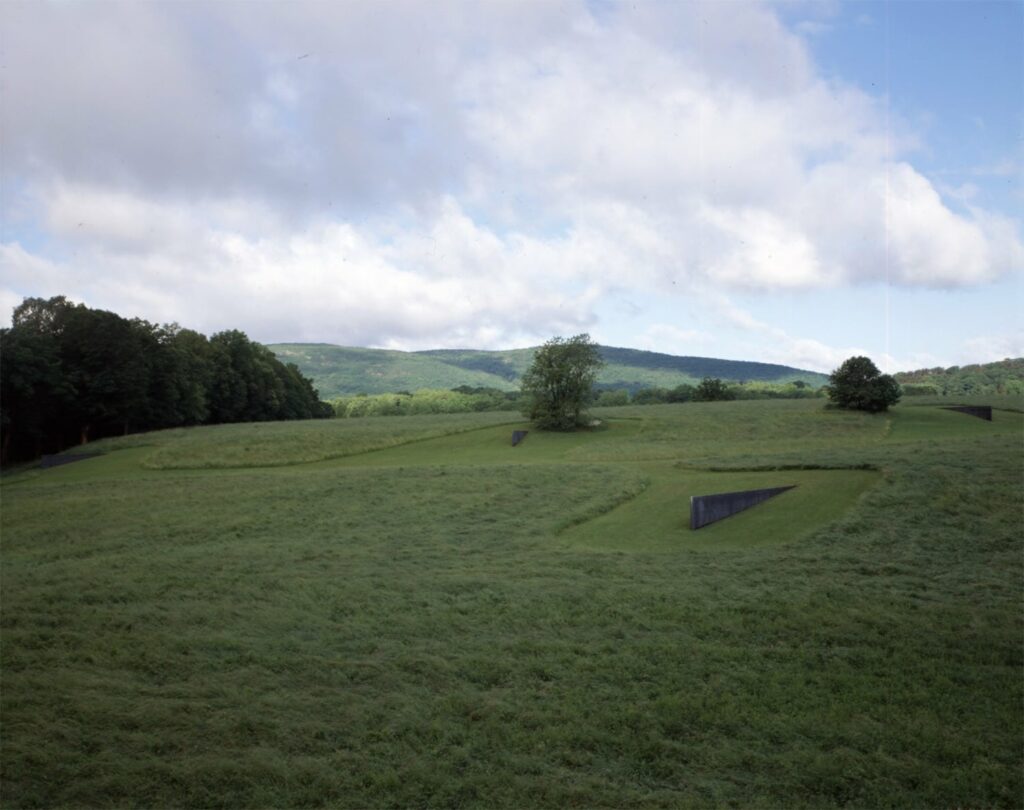
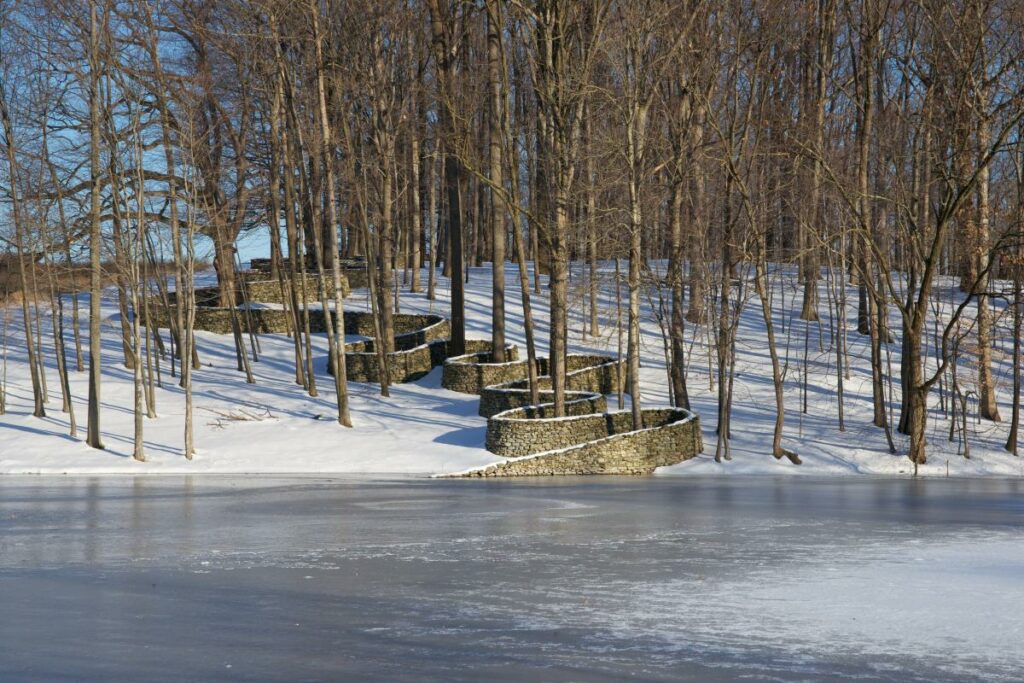
South Fields offers some of most spectacular views of the Storm King landscape and distant horizon, including the mountains of Hudson Highlands State Park. It also is the site of some of the museum-park’s most ambitious permanent works: Richard Serra’s Schunnemunk Fork (1990-91), four monumental steel plates that appear to carve the land as they rise from a lush rolling field; Andy Goldsworthy’s Storm King Wall (1997-98), a winding stone path built on the remnants of an original farm wall; and Maya Lin’s Storm King Wavefield (2007-08), a four-acre earthwork that emulates a sea of undulating waves. Using their respective landscapes as both material and memory, these site-responsive works place viewers directly within the land and its history, fostering environmental awareness and appreciation, and in the case of Lin’s Wavefield, transforming a former gravel pit into a reclamation site.
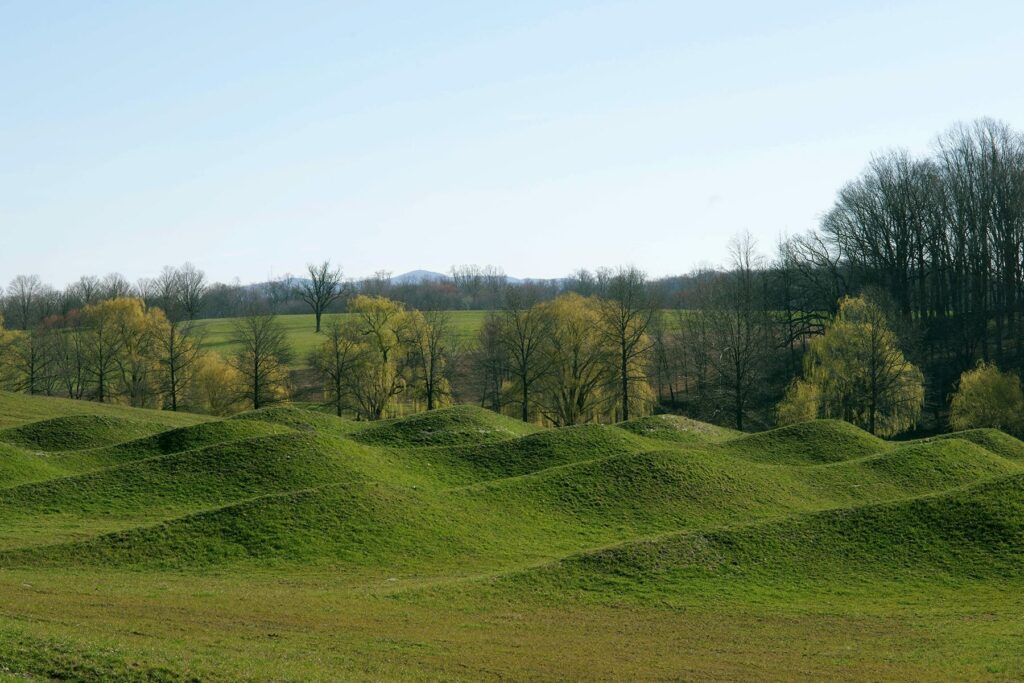
These kinds of direct experiences with art and nature have been suspended during our current pandemic, which forced many sculpture parks, including Storm King and Laumeier, to either temporarily close or limit public access. In response and in celebration of its 60th anniversary, Storm King has curated the online exhibition “Site Ecology: Land, Leadership, Art,” an extensive history of the museum, its collection, and campus through the lens of environmental conservation. The exhibition also coincides with a larger revitalization project that recently replaced 24 declining maple trees that once lined Maple Alleé – an arboreal corridor that runs north-south from the base of Museum Hill through the center of South Fields – with black gum trees, which are more resilient to changing climate and ground conditions. Several large-scale sculptures by Mark di Suvero – proud artifacts of a particular era of public art upon which many sculpture parks were founded – occupy the land just northwest of the alleé. Embodying permanence and monumentality over process and temporality, they stand in stark contrast to the more site-specific practices of “Indicators” and the land-based works I favor and describe above, yet like pins on a map provide welcome points of destination and scenic moments of pause.
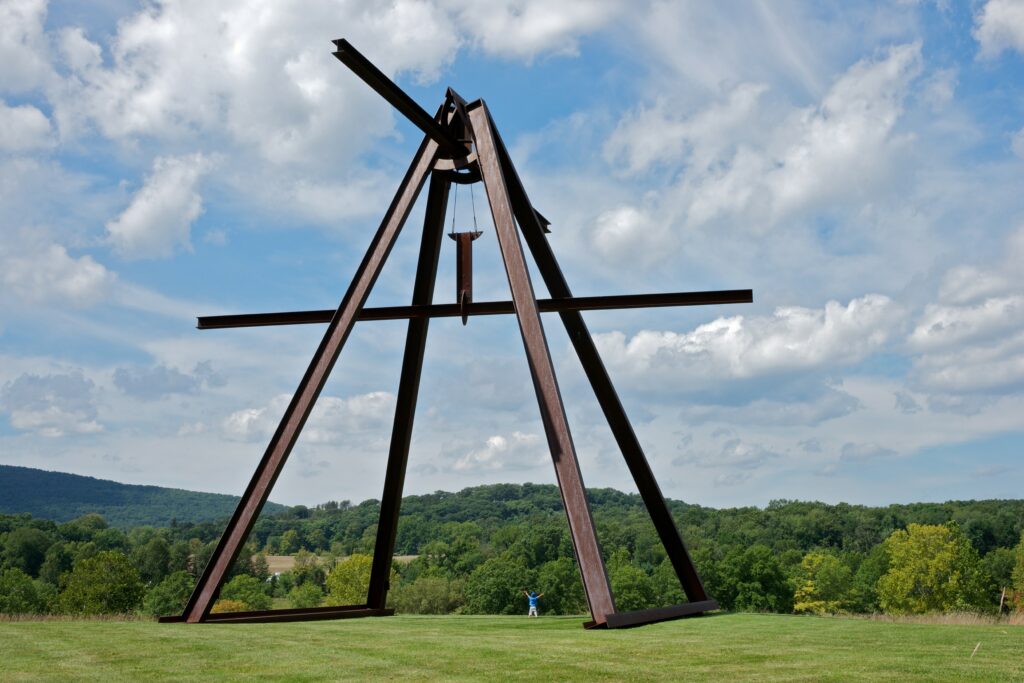
The Virginal B. Fairbanks Art & Nature Park
In a floodplain near the White River in Indianapolis lies The Virginia B. Fairbanks Art & Nature Park, part of an expansive 152-acre cultural campus that is also home to the Indianapolis Museum of Art (IMA). Known as Newfields: A Place for Nature & Art since 2017, the campus includes in addition to the IMA and Fairbanks Art & Nature Park, two historic, landmark houses, and The Garden, 40-acres of formal and contemporary gardens, an orchard, and working greenhouse. Departing from established models of outdoor museum parks by commissioning works rather than collecting large-scale public sculpture, the Art & Nature Park (originally 100 Acres) was conceived as an environment for site-specific projects that directly respond to and engage viewers with the campus’s physical landscape, a mixed ecology of wetlands and woodlands, with a meadow, manmade canal, and natural lake.
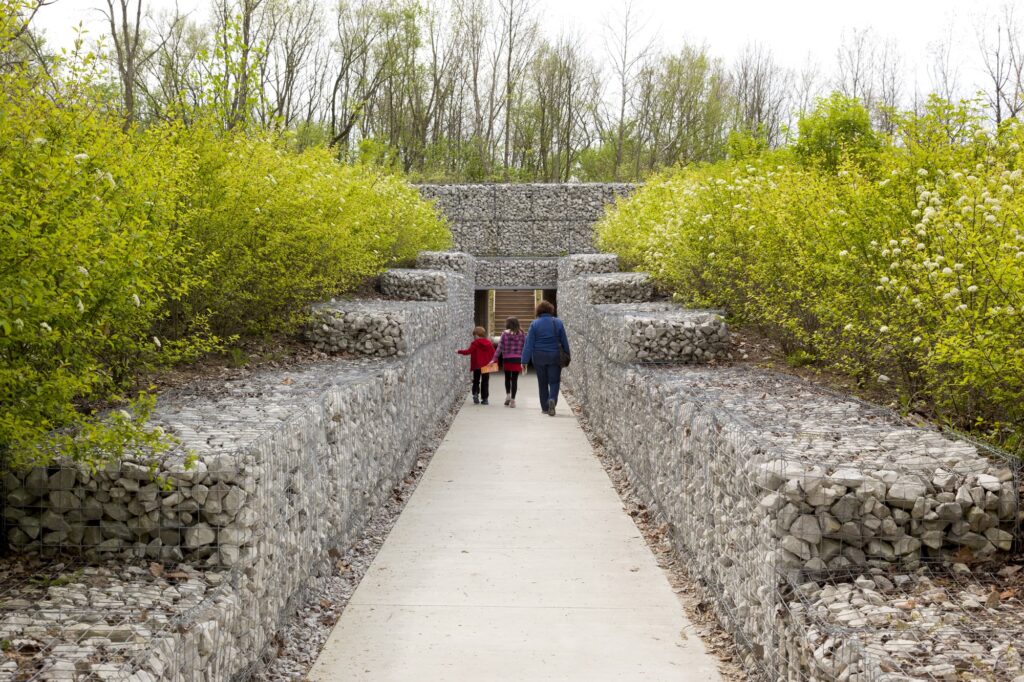
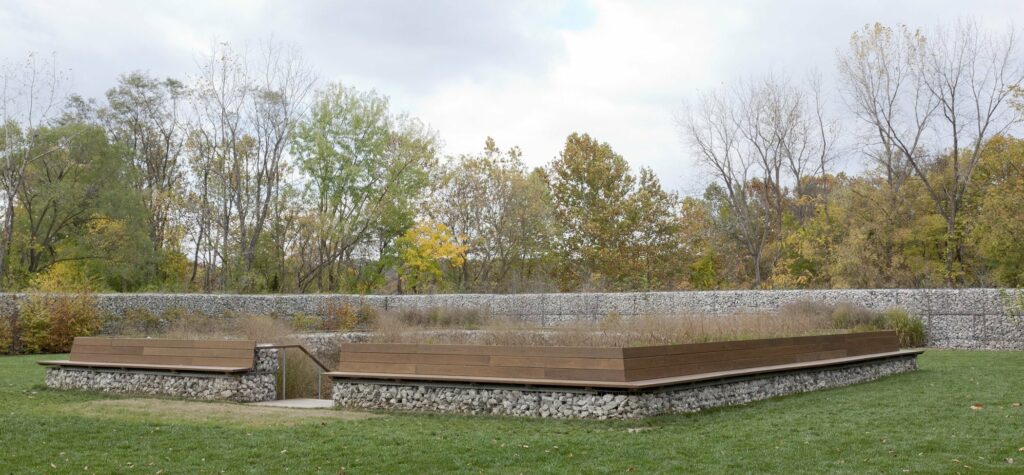
I have visited the park twice; the first, shortly after its opening in 2010 and more recently, on a hot, humid day last summer. After viewing an outstanding show of Japanese fashion designers Issey Miyake, Rei Kawakubo, and Yohji Yamamoto, I exited the museum and followed a wooded path that leads to the Art & Nature Park, where I was immediately greeted (and I must admit startled) by a young deer. The path ultimately directs wanderers to a narrow walkway that guides them through a dark concrete tunnel, then up a short flight of steps, where they are delivered to an open expanse of greenspace bordered by massive gabion rock walls. Wooden benches frame the stepwell, offering a space to rest and contemplate the silence of the inner park as well as the Art & Nature Park that surrounds it, which contains over 200 different native plants, including nearly 30 varieties of trees. Entitled Park of the Laments (2010), the entire structure is work of environmental architecture by Alfredo Jaar, a sanctuary that connects visitors to the landscape before them, while asking us to reflect upon the atrocities, both human and environmental, that have plagued the modern world. The work’s limestone rocks (indigenous to Indiana) symbols of destruction and nature, the salve that heals.
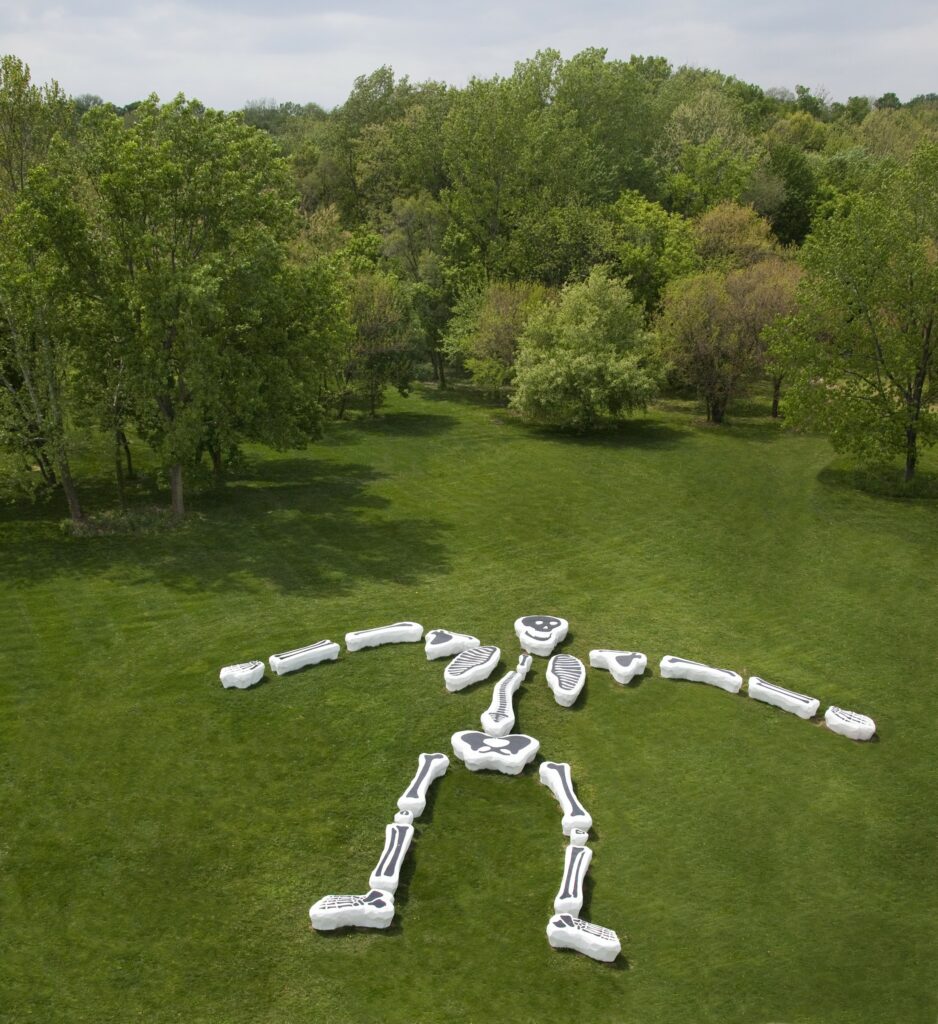
Park of the Laments is one of eight projects commissioned to inaugurate the Art & Nature Park, envisioned as a “living sculpture park” with site-specific works by an international group of artists, among them Kendall Buster, Atelier van Lieshout, Tea Makipaa, Type A, and Andrea Zittel. To this viewer, Park of the Laments it is also the park’s most defining moment, a work of straightforward yet redolent architecture where nature and the constructed meet in a generative embrace to nurture public and private acts of meditation. While all of the original works were conceived as temporary – with newly commissioned projects to be added yearly and others deinstalled as both the park and its varied landscape change over time – Park of the Laments is one of three installations acquired for Newfields’ permanent collection. Others include Freebasket (2010) by the Havana-based collective Los Carpinteros, who render the imaginary arcs of a bouncing ball as intersecting curves of red and blue steel, transforming an existing basketball court into an interactive sculpture, and Bench Around the Lake (2010) by Jeppe Hein, a series of shapeshifting benches that appear to emerge from the ground then bury themselves as they snake around the park’s 35-acre lake. (Kendall Buster’s temporary project Stratum Pier (2010), a viewing platform whose curvilinear form is based a topographical map of the park, also responds to the lake’s shoreline.)
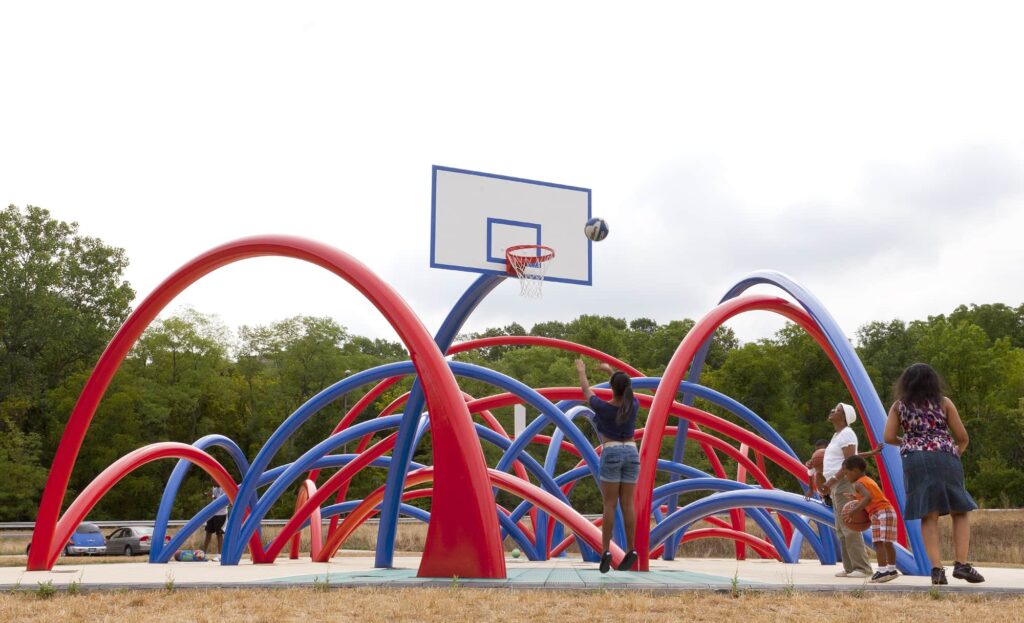

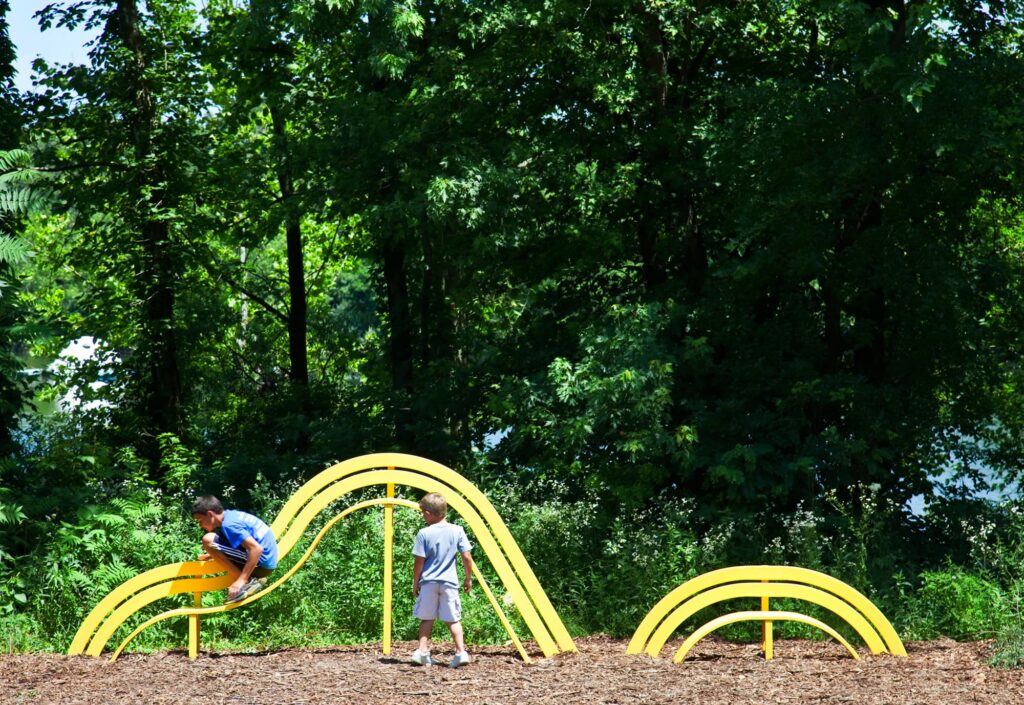
Yet despite its stated commitment to “experimentation, risk-taking, transformation, temporality, and dynamism,” (Note 5) much of the Art & Nature Park has remained relatively static over its ten-year history. Only one new work, Chop Stick by visiondivision, a concession stand with swings constructed from a 100-foot native poplar tree, was commissioned in 2012, and two of its more environmentally committed projects, those by Tea Makipaa and Andrea Zittel, are no longer on view. However, under the leadership of new Assistant Curator of Contemporary Art Michael Vetter and with over $21 million in recent grants and gifts, Newfields has embarked on a series of campus-wide initiatives that will bring renewed attention to environmental conservation of its local habitats and grounds, as well as commission new works for the Art & Nature Park. The first of these is an interactive project by Mexican designers Hector Esrawe and Ignacio Cadena, known for their brightly colored woven structures inspired by sources ranging from traditional crafts to children’s toys, to be installed in spring 2022. Likewise, a new endowment, The Hawryluk Collection of Art in Nature, will commission semi-annual, site-specific installations and also fund a sculpture green for larger, interactive works.
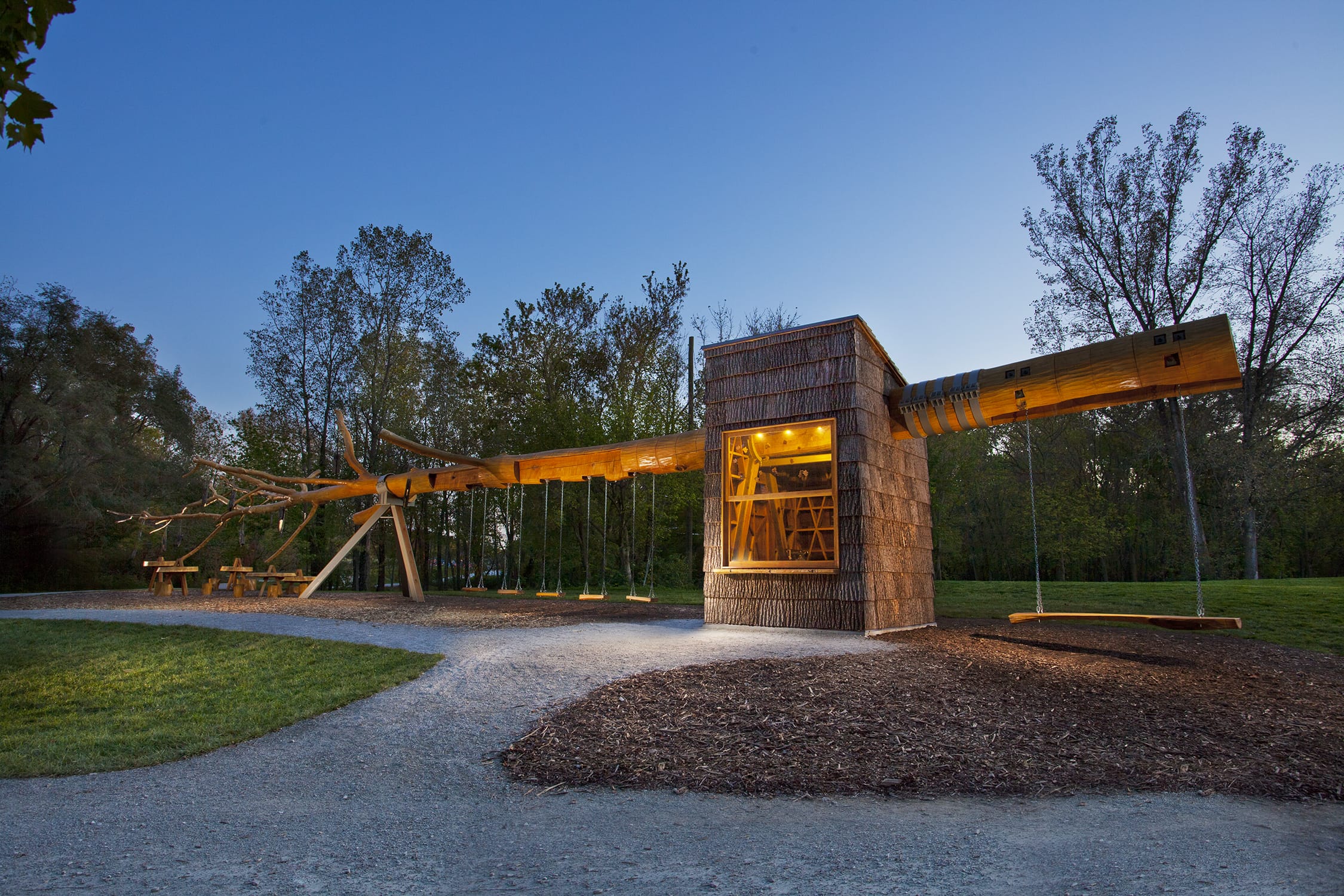
Vetter emphasizes that Newfields remains committed to temporary site-responsive projects rather than outdoor public sculpture or building a permanent collection, with a nod towards works utilizing more unconventional media and materials. In addition to creating meaningful interactions with nature, new commissions will also address more ecological themes: “Fairbanks has an exceptional level of biodiversity and several different kinds of terrain, so there is a lot of opportunity to create works of art that can educate our visitors about the ecology of Indiana and nature more broadly,” says Vetter. “I’d like our new commissions to deal conspicuously with environmental issues, whether that be something broad and global like climate change, or something very local, like the various species of birds that take up residence in the park.”
The ongoing stewardship of the larger campus, including the Art & Nature Park, falls under the care of Newfields’ Department of Horticulture and Natural Resources, directed by Johnathan Wright. In addition to overseeing the ground’s living collections of over 3,500 individual plant species, the department also helps site, install, and maintain commissioned works. According to Wright, the Natural Resource team has worked to remove invasive plants from the park and implement native plantings over the course of the last 15 years, including a pollinator meadow to enhance habitats for local bee and insect populations. Recent grant and gift monies have been used to mitigate erosion of the banks of the White River and the path around the lake, and to create low-cost, ecologically conscience access to the park through a new multi-use path, bikeshare station, and parking green.
Staking an identity separate from historic models of sculpture parks has presented the Art & Nature Park with both freedoms and risks. This strategy has been met with mixed reviews amidst claims that since the campus’s rebranding to Newfields in 2017 it has prioritized its natural assets over artistic ones with public programming focused more on entertainment than aesthetic engagement. (Note 6) Yet smaller in scale and less weighted by the demands of a large permanent collection, the Art & Nature Park has the ability to adapt more easily to the new material realities of contemporary art and environmental practices while continuing to respond to the changing needs of its local ecology. Poised with new creative resources, it also has the opportunity to revisit its original mandate – to present experimental artworks that challenge and engage audiences with the natural world we live in.
An Environmental Model
I am aware that many of the works I have written about here don’t necessarily belong to the larger purview of environmental art, but rather to various lineages of public sculpture and Land Art as well as contemporary landscape architecture and interventionist strategies that utilize the environment and its material sources. They are, however, all situated practices that commune with nature and ask us to do the same. In turn, outdoor sculpture parks, in their multitude of forms, configure these unique relationships between art and nature, offering scenic respites for artistic encounters and physical and mental well-being. Yet beyond cultural tourism and escapism, art and nature parks provide diverse spatial environments for aesthetic, scientific, and citizen explorations of local ecosystems. They uphold a kind of bioregionalism or place-based approach to ecology in which one’s cultural identity is defined by the natural characteristics of a given site and in relation to its other life forms, one that nurtures a sense of belonging and care for the environment.
Given our current pandemic and the fundamental rethinking of public space, outdoor sculpture parks have the inherent physical resources to create, facilitate, and sustain dialogues about climate change and public health, and to help envision safe, equitable access to nature and open spaces. And as museums and other cultural institutions consider how best to reopen and rethink their public missions, art and nature parks might be easily adapted models for supporting interdisciplinary art forms and knowledge sharing about the environment – particularly given the vast geographical territories, both urban and rural, museums often occupy – in which the stairs of the museum and the walls of the gallery give way to a new common ground.
Looking back, what little did I know that my experiences with Dion’s Memento Mori and Jaar’s Park of the Laments would become harbingers of the conflicts of the present and expressions of grief for all that has been lost in this difficult year. Restless from isolation and filled with a bit of wanderlust, I long for a return to the expanded field of nature and art.
Notes
Unless stated otherwise, all quotes taken from interviews with the author.
- “Mark Dion: Follies,” was on view February 15 – June 28, 2020 at the Laumeier Sculpture Park, St. Louis, MO, and May 4-November 11, 2019 at the Storm King Art Center, Cornwall, NY.
- Mark Dion in conversation with Denise Markonish, “Memento Mori (My Glass is Run) (2004),” in the exhibition catalog Mark Dion: Follies (NY: Storm King Art Center, 2019), p. 93.
- Quoted from Laumeier Sculpture Park Discovery Guide, 2013, p. 5.
- “Indicators: Artists on Climate Change” was on view May 19 – November 11, 2018, at Storm King Art Center, Cornwall, NY.
- As stated by Lisa D. Frieman, “100 Acres: A Living Sculpture Park for the 21st Century,” in 100 Acres: The Virginia B. Fairbanks Art & Nature Park (Indianapolis: Indianapolis Museum of Art, 2010), np.
- See Andrew Russeth, “The Ringmaster: Is Charles Venable Democratizing a Great Art Museum in Indianapolis—or Destroying It?” in ARTnews, July 9, 2019: https://www.artnews.com/art-news/news/charles-venable-newfields-indianapolis-museum-12938/.